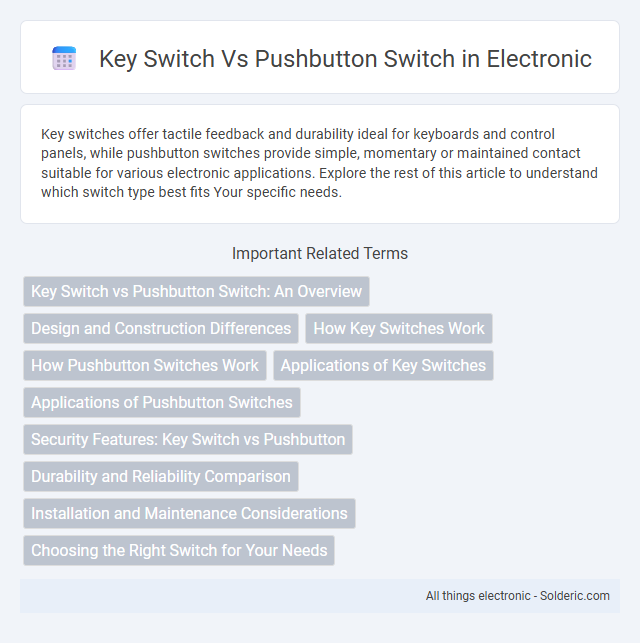Key switches offer tactile feedback and durability ideal for keyboards and control panels, while pushbutton switches provide simple, momentary or maintained contact suitable for various electronic applications. Explore the rest of this article to understand which switch type best fits Your specific needs.
Comparison Table
| Feature | Key Switch | Pushbutton Switch |
|---|---|---|
| Function | Activates circuits when a key is turned or pressed | Completes or breaks a circuit with a simple push |
| Operation Type | Rotary or toggle | Momentary or latching |
| Security | Provides physical security; requires a key to operate | No built-in security features |
| Application | Access control, ignition systems, security panels | Control panels, reset buttons, user inputs |
| Durability | High; designed for frequent use and security | Varies; generally less robust than key switches |
| Cost | Typically higher due to mechanical complexity and security | Generally lower and simpler |
Key Switch vs Pushbutton Switch: An Overview
Key switches provide secure, tamper-resistant control by requiring a physical key to operate, making them ideal for access control and restricted machinery. Pushbutton switches offer simple, quick activation with a single press, commonly used in user interfaces and control panels for ease of use. Your choice depends on whether security or convenience is the priority in your application.
Design and Construction Differences
Key switches feature a mechanical design with individual moving parts, often including springs and metal contacts, providing tactile feedback and durability ideal for keyboards and control panels. Pushbutton switches are typically simpler in construction, consisting of a plunger mechanism that completes an electrical circuit when pressed, used in devices requiring quick, momentary activation. Your choice depends on the application's need for precision, feedback, and longevity, as key switches offer enhanced reliability compared to basic pushbutton designs.
How Key Switches Work
Key switches operate by using a mechanical or electrical mechanism triggered when a key is turned or pressed, completing a circuit to activate or deactivate a device. Unlike pushbutton switches that rely on simple pressing action, key switches often include locking features for enhanced security and controlled access. These switches are commonly used in applications such as security systems, control panels, and restricted access equipment where authorized operation is critical.
How Pushbutton Switches Work
Pushbutton switches operate by completing or interrupting an electrical circuit when pressed, allowing current to flow or stopping it instantly. These switches are momentary, meaning they only maintain their electrical connection while the button is actively pressed, making them ideal for applications requiring temporary activation. Common in devices like keyboards and control panels, pushbutton switches offer simple, reliable mechanical action for user input.
Applications of Key Switches
Key switches are commonly used in security-sensitive applications such as access control systems, industrial machinery, and public transportation ticketing where authorized operation is required. Their robust design and ability to prevent unauthorized activation make them ideal for controlling power supplies, machinery start-ups, and alarm systems. These switches are favored in environments demanding durability and precise operational control.
Applications of Pushbutton Switches
Pushbutton switches are widely used in applications requiring momentary user input, such as control panels, home appliances, and industrial machinery. These switches offer quick, reliable activation for functions like resetting devices, triggering alarms, or operating doorbells. Your choice of a pushbutton switch ensures precise control in environments demanding frequent, short-term engagement.
Security Features: Key Switch vs Pushbutton
Key switches offer enhanced security features through their physical key mechanism, restricting access to authorized users only and preventing unauthorized activation. Pushbutton switches lack built-in security measures, making them vulnerable to accidental or unauthorized operation in sensitive environments. Integrating a key switch ensures controlled access and reduces the risk of tampering compared to standard pushbutton switches.
Durability and Reliability Comparison
Key switches typically offer higher durability, with mechanical designs rated for millions of actuations, making them ideal for heavy-use environments such as industrial machinery or gaming keyboards. Pushbutton switches, while often more cost-effective, generally have a shorter lifespan due to simpler mechanisms and frequent wear from repeated pressing, commonly rated for tens to hundreds of thousands of cycles. Reliability of key switches is enhanced by their robust construction and tactile feedback, whereas pushbutton switches may suffer from contact bounce or failure over extended use in demanding applications.
Installation and Maintenance Considerations
Key switches typically require precise mounting holes and secure locking mechanisms, making installation more involved compared to pushbutton switches, which often snap into place easily on panel cutouts. Maintenance of key switches involves periodic lubrication and key mechanism checks to ensure smooth operation and prevent jamming, while pushbutton switches generally require less frequent maintenance due to simpler internal components. Selecting between these switches depends on the desired durability, security needs, and ease of access for routine inspections or replacements.
Choosing the Right Switch for Your Needs
Choosing the right switch depends on your specific application requirements and user interface preferences. Key switches provide tactile feedback and durability, ideal for mechanical keyboards and equipment requiring precise, reliable actuation. Pushbutton switches offer simplicity and versatility, commonly used in control panels and devices where momentary or maintained contact is necessary.
key switch vs pushbutton switch Infographic

 solderic.com
solderic.com